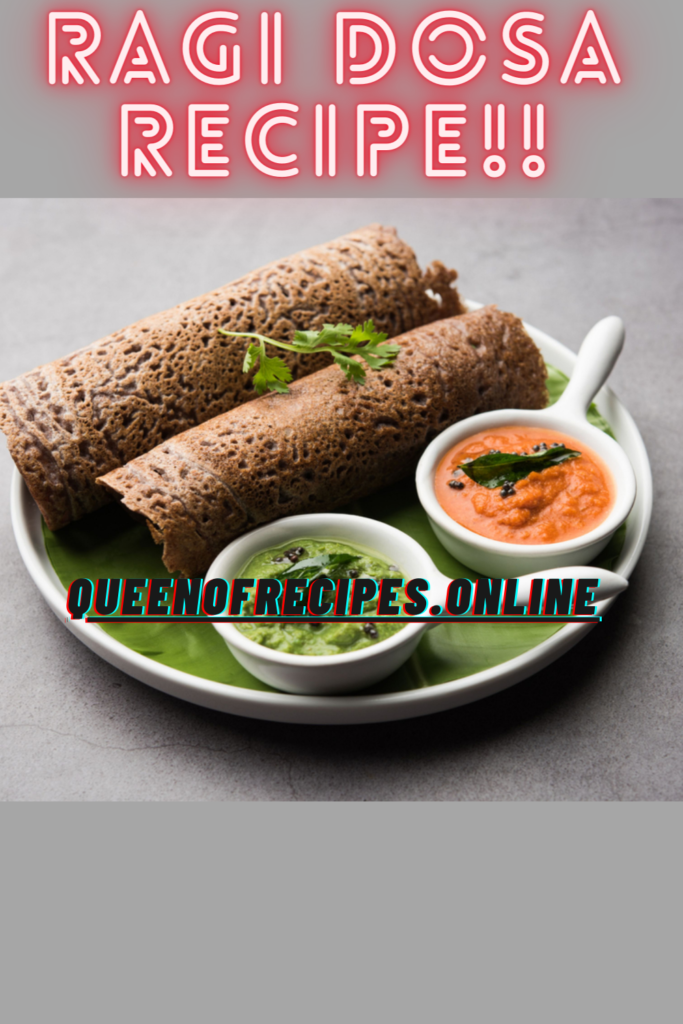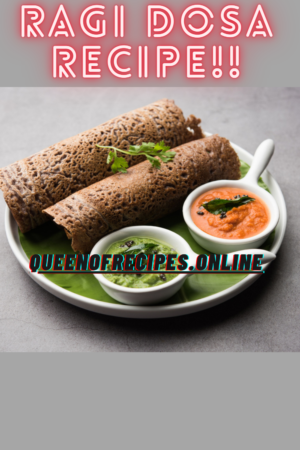Table of Contents
About Ragi Dosa.
Ragi dosa is a nutritious and gluten-free variation of the traditional South Indian dosa. It is made using ragi flour, which is derived from finger millet, a highly nutritious and drought-resistant grain. Ragi dosa is known for its distinct earthy flavor, soft and slightly crispy texture, and its significant health benefits.
To prepare ragi dosa, ragi flour is combined with rice flour, urad dal (black gram), and sometimes other ingredients like grated coconut or fenugreek seeds. The batter is fermented, giving the dosa its characteristic tangy taste. It is not only a favorite breakfast option in South India but has gained popularity worldwide due to its gluten-free nature and the numerous health advantages associated with ragi.
This dosa is often served with various accompaniments such as coconut chutney, sambar, or a spicy tomato-based chutney. Its combination of flavor, nutrition, and versatility makes ragi dosa a wholesome and satisfying meal choice for those seeking a healthier alternative to traditional dosas.
Ingredients for Ragi Dosa:
For the Batter:
- 1 cup ragi flour (finger millet flour)
- 1/2 cup rice flour
- 1/4 cup urad dal (black gram lentils)
- 1/4 cup poha (flattened rice)
- A pinch of fenugreek seeds (optional)
- Salt to taste
- Water, as needed
For the Dosa:
- Oil or ghee for greasing the pan
Instructions:
Preparing the Batter:
- Rinse and Soak: Rinse the urad dal and poha in water. Add fenugreek seeds if using. Soak them together in enough water for 4-5 hours or overnight.
- Grind: Drain the soaked urad dal, poha, and fenugreek seeds. Grind them to a smooth paste using as little water as necessary. Transfer this paste to a large mixing bowl.
- Add Flours: Add ragi flour, rice flour, and salt to the urad dal paste. Mix well.
- Ferment: Add water gradually while stirring to achieve a batter with a dosa batter-like consistency. It should be slightly thicker than crepe batter. Cover the bowl and let it ferment for 6-8 hours or overnight in a warm place. The batter will rise and become slightly bubbly.
Making Ragi Dosa:
- Heat the Griddle: Heat a non-stick dosa tava or griddle on medium-high heat. Sprinkle a few drops of water on the griddle; if it sizzles and evaporates, the griddle is ready.
- Grease the Griddle: Grease the griddle with a little oil or ghee using a brush or a small piece of onion or potato.
- Pour the Batter: Pour a ladleful of the ragi dosa batter onto the center of the hot griddle. Use the back of the ladle to gently spread the batter in a circular motion to form a thin dosa.
- Cook the Dosa: Drizzle a few drops of oil or ghee on the dosa. Cook on medium heat until the edges start to turn crisp and golden, and the surface appears cooked.
- Flip the Dosa: Gently flip the dosa using a spatula and cook the other side for a minute or so until it turns golden and crispy.
- Serve: Transfer the ragi dosa to a plate. Repeat the process for the remaining batter. Serve hot with coconut chutney, sambar, or any chutney of your choice.
Ragi dosa is a healthy and gluten-free breakfast option that’s not only nutritious but also delicious. Enjoy its unique flavor and the goodness of finger millet in each crispy bite!


Nutritional Value.
Ragi dosa is a highly nutritious dish, owing much of its nutritional value to the main ingredient, finger millet (ragi). Here’s an approximate nutritional profile for a typical serving of ragi dosa (one dosa):
- Calories: Approximately 100-120 calories per dosa.
- Carbohydrates: About 20-25 grams, primarily from ragi and rice flour.
- Protein: 2-3 grams, largely from urad dal (black gram) in the batter.
- Dietary Fiber: 2-3 grams, contributed by ragi and poha (flattened rice).
- Fat: Minimal fat content, as it’s a low-fat preparation.
- Vitamins and Minerals: Ragi is rich in calcium, iron, and other minerals. It also contains vitamins B1 (thiamine), B2 (riboflavin), and B3 (niacin).
Additionally, ragi dosa is gluten-free, making it suitable for individuals with gluten sensitivities or celiac disease. It’s a good source of complex carbohydrates and dietary fiber, which contribute to a feeling of fullness and steady energy release. The urad dal used in the batter provides protein, and the fermentation process enhances nutrient absorption.
Overall, ragi dosa is a nutritious and balanced meal option, particularly when paired with nutrient-rich accompaniments like sambar and coconut chutney.
Health Benefits.
Ragi dosa offers a range of health benefits, making it a popular choice for those seeking a nutritious and gluten-free meal option. Here are some of the health benefits associated with consuming ragi dosa:
- Rich in Nutrients: Ragi (finger millet) is a nutritional powerhouse, packed with essential nutrients such as calcium, iron, dietary fiber, and B vitamins (thiamine, riboflavin, niacin). These nutrients are vital for bone health, iron absorption, and overall well-being.
- Gluten-Free: Ragi dosa is naturally gluten-free, making it a suitable choice for individuals with celiac disease or gluten sensitivities. It provides a safe and nutritious alternative to wheat-based foods.
- High in Fiber: Ragi is a good source of dietary fiber, which aids in digestion, helps maintain a feeling of fullness, and supports digestive health by preventing constipation.
- Balanced Carbohydrates: Ragi dosa provides complex carbohydrates, which release energy slowly, promoting steady blood sugar levels and sustained energy throughout the day.
- Protein Content: The urad dal (black gram lentils) used in the batter adds a source of protein to the meal, contributing to muscle repair and overall protein intake.
- Low in Fat: Ragi dosa is a low-fat food, making it suitable for those looking to manage their fat intake while enjoying a wholesome meal.
- Fermented: The fermentation process involved in making dosa batter enhances nutrient absorption and makes nutrients more bioavailable, such as iron and certain B vitamins.
- Weight Management: The combination of high dietary fiber and low fat in ragi dosa can help with weight management by promoting a sense of fullness and reducing overall calorie intake.
- Bone Health: Ragi is a good source of calcium, which is essential for strong bones and teeth. It is especially beneficial for individuals at risk of calcium deficiency.
- Versatile: Ragi dosa can be customized with various fillings and accompaniments, allowing for versatility in flavors and nutrients. It pairs well with vegetables, chutneys, and sambar, enhancing its overall nutritional profile.
- Heart Health: The fiber content and low saturated fat in ragi dosa may contribute to heart health by helping to lower cholesterol levels and reduce the risk of heart disease.
- Diabetes Management: The slow-release carbohydrates in ragi dosa may help regulate blood sugar levels, making it a suitable option for individuals with diabetes when consumed in moderation.
Overall, ragi dosa is a wholesome and nutritious choice that offers a wide range of health benefits. Incorporating it into a balanced diet can contribute to improved overall health and well-being.
Tips and Tricks.
Making perfect ragi dosa requires some tips and tricks to achieve the desired texture and flavor. Here are some useful tips for preparing delicious ragi dosa:
1. Fermentation Time: Allow the dosa batter to ferment for at least 6-8 hours or overnight. This fermentation process not only improves the taste but also makes the dosa easier to digest.
2. Batter Consistency: Achieve the right batter consistency; it should be slightly thicker than crepe batter but still pourable. Adjust with water or flour as needed.
3. Smooth Batter: Ensure the batter is free of lumps. You can use a hand blender or whisk to achieve a smooth consistency.
4. Rest the Batter: After fermentation, stir the batter gently before making dosas. This ensures an even distribution of air bubbles.
5. Properly Heated Griddle: Heat the dosa griddle or tava well before making dosas. To check if it’s hot enough, sprinkle a few drops of water on it – they should sizzle and evaporate.
6. Grease the Griddle: Use a small piece of onion or potato dipped in oil to grease the griddle evenly. This imparts a subtle flavor to the dosa.
7. Correct Ladle Size: Use a ladle or cup with a proper size to pour the batter onto the griddle. The dosa should not be too thick or too thin.
8. Spreading the Batter: Use the back of the ladle to gently spread the batter in a circular motion from the center outward to form a thin dosa. You can use a light hand to avoid tearing.
9. Control Heat: Maintain medium heat when cooking dosas. If the griddle is too hot, the dosa may brown too quickly and become crispy, losing its softness.
10. Flip Gently: When the edges of the dosa start to turn golden and crisp, gently flip it with a spatula. Be cautious to avoid tearing the dosa.
11. Topping Options: You can add various toppings like grated coconut, chopped onions, or chopped cilantro on the dosa just after spreading the batter for added flavor and texture.
12. Serve Hot: Ragi dosa is best enjoyed immediately when it’s hot and crispy. Serve it with your choice of accompaniments like coconut chutney or sambar.
With these tips, you can master the art of making delicious and perfectly textured ragi dosa, ensuring a delightful and nutritious meal for yourself and your loved ones.


Serving Suggestions.
Ragi dosa can be served in a variety of ways, making it a versatile and delicious meal option. Here are some serving suggestions to enhance your ragi dosa experience:
- Coconut Chutney: Ragi dosa pairs exceptionally well with coconut chutney. Prepare a fresh coconut chutney with grated coconut, green chilies, ginger, and a tadka (tempering) of mustard seeds, urad dal, and curry leaves for added flavor.
- Sambar: Serve ragi dosa with piping hot sambar, a flavorful South Indian lentil and vegetable stew. The combination of dosa and sambar is both hearty and nutritious.
- Tomato Chutney: A tangy and spicy tomato chutney is another excellent accompaniment for ragi dosa. It’s made with tomatoes, onions, red chilies, and spices.
- Mint Chutney: Mint chutney adds a refreshing twist to your ragi dosa. Blend fresh mint leaves with yogurt, green chilies, and spices for a cool and tangy dip.
- Pickles: Some people enjoy dosa with a side of tangy mango or lime pickle. The contrast of flavors can be quite appetizing.
- Potato Masala: For a filling meal, serve ragi dosa with a classic South Indian potato masala (aloo masala). The spiced potato mixture complements the dosa’s flavors.
- Onion-Tomato Toppings: Sprinkle finely chopped onions and tomatoes on the dosa just after spreading the batter. This adds a delightful crunch and freshness.
- Yogurt: A simple bowl of yogurt, either plain or spiced with a pinch of salt and cumin powder, complements the dosa well.
- Tamarind Chutney: Tangy tamarind chutney can be drizzled on the dosa or served on the side for added flavor.
- Paneer or Cheese: If you prefer a fusion twist, stuff the dosa with paneer (Indian cottage cheese) or sprinkle grated cheese inside and fold it over for a cheesy treat.
- Fresh Fruits: Pair ragi dosa with a side of fresh fruit salad for a healthy and refreshing combination.
- Masala Chai: Enjoy your dosa with a cup of hot masala chai (spiced tea) for a complete breakfast or snack experience.
These serving suggestions allow you to customize your ragi dosa according to your taste preferences, making it a delightful and satisfying meal. Experiment with different combinations to discover your favorite way to enjoy this nutritious dish.
FAQs.
Can I make instant ragi dosa without fermentation?



Yes, you can make instant ragi dosa without fermentation. To do this, use yogurt or buttermilk as a substitute for fermentation. Simply mix ragi flour, rice flour, urad dal (black gram) flour, and other ingredients with yogurt or buttermilk to create a smooth batter. Allow the batter to rest for about 15-20 minutes to improve its texture, and then you can make dosas immediately. This quick method yields dosas with a slightly different flavor and texture compared to traditionally fermented ones but is a convenient option when you’re short on time.
Is ragi dosa suitable for diabetic individuals?



Yes, ragi dosa can be suitable for diabetic individuals when consumed in moderation as part of a balanced diet. Ragi has a low glycemic index, which means it can help regulate blood sugar levels and prevent rapid spikes. The high fiber content in ragi dosa also aids in maintaining steady blood sugar. However, it’s essential to monitor portion sizes, control the use of oil or ghee, and pair it with low-glycemic accompaniments like sambar or coconut chutney to maintain stable blood glucose levels. It’s advisable for individuals with diabetes to consult a healthcare professional or a dietitian for personalized dietary recommendations.
Is ragi dosa suitable for weight loss?



Yes, ragi dosa can be a suitable addition to a weight loss diet. Ragi is rich in dietary fiber, which helps create a feeling of fullness and prevents overeating. Additionally, ragi dosa is relatively low in fat. By maintaining portion control and avoiding excessive use of oil or ghee while cooking, ragi dosa can be a satisfying and nutritious meal option for those looking to manage their weight. Pairing it with healthy accompaniments like sambar and vegetable chutney adds to its weight loss suitability.
Can I make sweet ragi dosa?



Yes, you can make sweet ragi dosa by adding ingredients like jaggery (unrefined sugar), cardamom powder, and grated coconut to the dosa batter. Simply mix these sweet components into the batter to create a mildly sweet and aromatic variation of ragi dosa. This sweet version is often enjoyed as a dessert or snack and can be a delightful way to satisfy your sweet cravings while still benefiting from the nutritional qualities of ragi.

